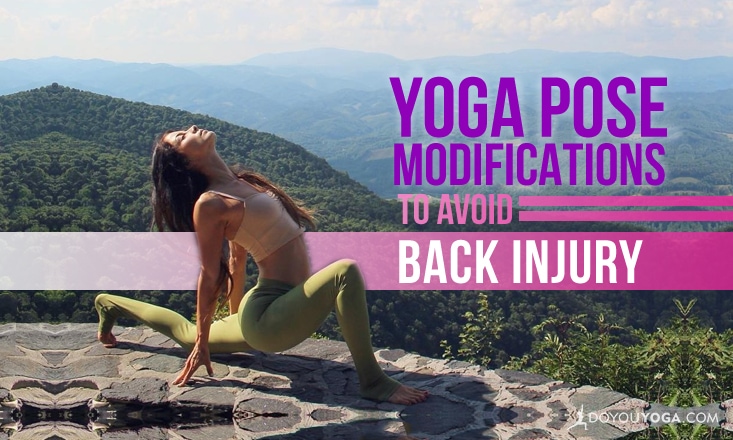Back pain is fairly common and can result from injury such as a sprain or a strain. It can be brought on by simple movements or more strenuous actions, like lifting heavy objects. Physical exercise such as weight lifting and yoga can also result in back injury when not performed properly.
As practitioners of yoga, we want to create a practice that is safe and sustainable ensuring longevity. The following are 5 yoga poses and modifications that will help to keep the back safe (and strong), preventing injury.
NB: If you already experience back pain or have an existing, specific back injury, please work closely with an experienced yoga teacher or better yet, consult your physician before practicing the following postures.
1. Uttanasana or Standing Forward Fold
 Credit: Anna Coventry
Credit: Anna CoventryThis pose helps to bring length to the back line of the body. It is an excellent posture to lengthen the hamstrings, but it also has the potential to strain the lower back if not done correctly.
While a slight rounding of the back is fine, you want to maintain integrity of the spine. You can modify your Uttanasana by placing hands on the shin bones, or hands on one or two yoga block(s). Doing so helps to bring space into the spine whilst forward bending.
2. Paschimottanasana or Seated Forward Bend
 Credit: Chara Caruthers
Credit: Chara CaruthersPaschimottanasana is a seated forward fold that stretches the spine and hamstrings, and is typically used at the end of a practice. Like Uttanasana, there is risk of straining the lower back when it is done forcefully and without awareness of creating space.
 Credit: Kaisa Kapanen
Credit: Kaisa KapanenIf you find it difficult to reach for your feet in Paschimottanasana, you can modify and maintain integrity of the spine by using a strap around the arches of the feet. Holding tight to the strap, reach back through the sit bones as you lift through the centre of the chest and reaching forward with the heart by bending your elbows.
You can additionally modify by keeping a bend in the knees. Both of these modifications help to maintain space in the lower back reducing the risk of injury.
3. Twisting Postures
Any twist postures (e.g., Pavritta Parsvakonasana, Ardha Matsyendrasana, etc.) should be practiced mindfully with an intention to lengthen the spine on an inhale, and twisting on the exhale with the navel drawing inwards.
Drawing the navel inwards creates core engagement, supporting the spine as it twists, minimizing the potential for injury. Students who have existing disc issues in their lower back are advised to stay away from deep twists, or to work closely with an experienced yoga instructor.
Modifying postures are a great way to avoid back injury. Another excellent way to help keep the back healthy and free from injury is to stretch the psoas, a muscle belonging to the hip flexors, and the hamstrings.
4. Anjaneyasana or Low Lunge Pose
 Credit: Anna Coventry
Credit: Anna CoventryThe psoas is an important flexor that runs from the front of the spine and attaches to the head of the thigh bone. As a result of long periods of sitting, the psoas shortens or tightens, which then puts strain on the lower back.
If we open up the psoas, we also help bring greater freedom into the lower back, minimizing the risk of injury. Anjaneyasana or Low Lunge pose helps to stretch the hip flexors, including the psoas.
How to do it: From Downward Dog, step the right foot forward with the knee above the heel, lower the back knee onto the mat, and rest both hands on the right thigh (or lift the arms overhead), drawing the navel in.
As the psoas is a deep muscle, think of hugging the front heel and back knee towards the midline, and feel how that energetic engagement accesses a deeper stretch along the front of the hip. Hold for 5 to 10 breaths and repeat on the other side.
5. Ardha Hanumanasana or Half Splits Pose
 Credit: Julia Lee
Credit: Julia LeeThe hamstrings run along the back of each thigh and when tight can, not only keep you from touching your toes, but also limit motion in the pelvis which can create stress across the lower back. Ardha Hanumanasana or half monkey pose/half splits is a fairly accessible posture that stretches the hamstrings and also lengthens the spine.
From Anjaneyasana, lower the hands to the mat and frame the front foot. Shift the pelvis back, so the back leg knee is below the hip, and the front leg is straight. Hands on the mat below the shoulders (or blocks, if needed). Inhale to lengthen the spine, and keep the sternum lifted as you draw forward over the front thigh. Hold for 5 to 10 breaths and repeat on the other side.
We can use modifications to keep our bodies safe in the practice of yoga. We can also focus on lengthening certain muscle groups to create more freedom in the body which helps minimise the risk of injury.
The most important thing we can do, however, is to practice mindfully and with integrity. Tuning into the needs of your body, and backing off when you need is what will ultimately help you cultivate a sustainable and injury-free practice.
Image credit: Odette Hughes



